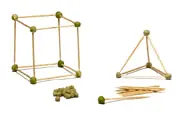Gift Ten: The Framework Gift
The Gifts are progressively sequenced in a gradual shift from the concrete idea of solid forms to the abstract idea of “spatial patterns.” The 10th and final Gift brings the cycle full circle by combining the point and line to create a framework of solid forms. In this way, abstract ideas of shape, form and space composed of arbitrary lines and points (imaginary three-dimensional solids) can be realized in concrete form. For this experience, all the previous Gift play has built a foundation in the child as he/she internalized this experience.

To best explain Gift 10, it is important to recap Froebel’s system. Froebel divided his kindergarten activities into Gifts and Occupations. The Gifts were materials that could return to their original form while Occupations were crafts that could not be undone. Due to their limited technological means, the early kindergartens did not have a solution for a framework Gift. Actual construction of frameworks was handled in the Occupation of peas-work. This involved soaking dried peas overnight until they were soft enough for toothpicks to be used to connect them. Once the peas dried, the creations were set.
Many wonderful toys, including Tinkertoys, Erector sets, Kinex, Zometool, and other architectural toys that provide a re-usable construction experience have been developed since Froebel’s time. Any of these materials could function as Gift 10 if they are introduced with a Froebelian approach. The idea for all the Froebel Gifts is not to become obsessed with the materials, but with the experiences of the children. If the idea of combining points and lines to form the framework of solids is experienced by the child, the material can rightly be called Gift 10.
As for guidelines for introducing these experiences, the basics still apply. Limit the number of materials (points and lines) initially until the child is ready to experience more complicated arrangements. Perhaps you might introduce this new Gift by returning to the solid cube of Gift 2. Allow the child to recognize the point and the line and naturally construct two-dimensional forms (triangle, square, etc.). The child will naturally tie the ideas of all the previous Gift play together as he/she becomes ready for this concept.

